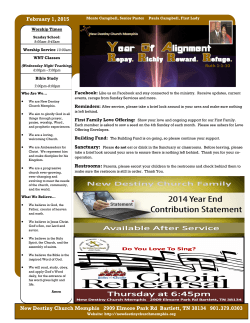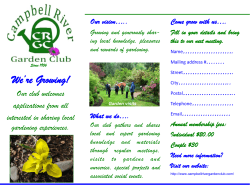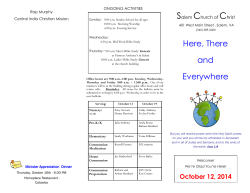
W.W. CAMPBELL - Hancock Historical Museum
Product/Service Information WILLIAM WALLACE CAMPBELL William Wallace Campbell was born just east of Van Buren, Ohio, on April 11, 1862. He graduated from high school in Fostoria, Ohio in 1880. From his humble beginnings in Hancock County, Campbell would go on to receive international acclaim for his scientific achievements. While studying at the University of Michigan, Campbell discovered his passion for astronomy. After receiving his engineering degree in 1886, he became Director of the Lick Observatory, atop Mt. Hamilton in central California. Later, he was named President of the University of California, and ultimately, President of the National Academy of Sciences. He was nominated for the Nobel Prize in 1900. Today, Campbell has an asteroid named after him, as well as a crater on Mars and a crater on the Moon. W.W. Campbell can rightfully be recognized as one of Ohio’s greatest native scientists—an intrepid world explorer and innovator. “The great ones (problems), Dr. Campbell faced greatly, seeing them in the full prospective of their long future and wide ramifications, as was natural to a scientist whose habitual intellectual background had been the whole harmony of the universe.” - W.H. Wright Photograph courtesy of Margaret Campbell Rhoads. (Front cover) Photograph courtesy of Margaret Campbell Rhoads. 422 W. SANDUSKY ST. FINDLAY, OH 45840 (419)423-4433 www.hancockhistoricalmuseum.org HOURS Wednesday-Friday: 10am-4pm Sunday: 1-4pm ADMISSION Adults—$5 Seniors—$3 Children—$2 Families—$12 This exhibit made possible with generous assistance from: OBSERVING THE HARMONY OF THE UNIVERSE W.W. CAMPBELL The Charles J. Younger Fund Findlay-Hancock County Community Foundation The Mariann Dana Younger Fund Findlay-Hancock County Community Foundation Mr. David Ferguson & Ms. Karen Schwarzwalder Mrs. Margaret Campbell Rhoads Ms. Martha Campbell THE LIFE & ACCOMPLISHMENTS OF ONE OF OHIO’S GREATEST NATIVE SCIENTISTS April 10—November 15, 2015 W.W. Campbell Day in Hancock County— April 11, 2015 EXHIBIT The exhibit includes images and artifacts from William Wallace Campbell’s early life in Hancock County, as well as his tenure as the Director of the Lick Observatory and President of the University of California. Items on loan from the Lick Observatory include the Brashear lens from the Einstein camera, a chronometer, holograph observing books, and several other instruments used by Campbell in his research. Items on loan from the University of California-Santa Cruz Special Collections & Archives include the Medal from the Royal Astronomical Society Institute (1906), the Bruce Medal (1915), the Draper Medal (1882), the LaLande Medal (1903), the Janssen Medal (1910), and the American Association for Advancement of Science Medallion. A Story Uncovered. Campbell’s link to Hancock County had been all but forgotten until 2014, when Findlay resident, David Ferguson, stumbled across a brief biography on Campbell as he searched for an interesting topic to present to the local Symposium Club. Ferguson was intrigued by Campbell’s life story and was compelled to learn more when he discovered that local historians knew very little of the noteworthy scientist’s local connection. David’s research led him to California, where he met with representatives from the Lick Observatory, University of California-Santa Cruz Special Collections & Archives, and Campbell family members— Martha Campbell & Margaret Campbell Rhoads. With their generous assistance, and additional financial support from the Charles J. Younger and Mariann Dana Younger Funds of the FindlayHancock County Community Foundation, the Hancock Historical Museum has created an exhibit honoring the lifetime accomplishments of W.W. Campbell and the far reaching implications of his scientific research. In 2015, on his 153rd birthday, W.W. Campbell will receive local recognition that is long overdue. The Hancock County Commissioners will declare April 11th “William Wallace Campbell Day” . Photograph courtesy of Margaret Campbell Rhoads. The exhibit will be on display from April 10thNovember 15th, 2015. Scientific Achievement. Campbell was a pioneer of astronomical spectroscopy—the study of visible light and wavelengths— which is used to derive many properties of distant stars and galaxies. He also explored the radial velocity of stars, and calculated that our solar system is moving through space at a rate of 14 miles per second. Campbell led seven solar eclipse observation expeditions all over the world, including India, Spain, and the Ukraine. In 1922, Campbell led an expedition to Australia. He collected data that demonstrated that light from distant stars would, in fact, be bent by the Sun’s gravitational field, as predicted by Albert Einstein. Campbell proved Einstein’s thennovel theory of relativity. W.W. Campbell authored or co-authored nearly 350 scholarly articles, books, essays and lectures, and was widely influential in scientific circles around the globe. Photograph of the Lick Refractor courtesy of Laurie Hatch. Content courtesy of David Ferguson. CALENDAR April 10th, 10am—Public opening of exhibit April 11th—William Wallace Campbell Day 8:00am-4pm : Ohio Local History Alliance Regional Meeting at the Hancock Historical Museum w/ Proclamation by Hancock County Commissioners 6pm: Lecture by David Ferguson at the Hancock County Agency on Aging-Senior Center April 20th , 12pm—Lecture by David Ferguson at Findlay Rotary Club (Findlay Country Club) November 1st , 1:30--3:30pm—Funday Sunday at the University of Findlay’s Mazza Museum November 15th, 1-4pm—Final day of exhibit Background image of Lick Observatory courtesy of Laurie Hatch.
© Copyright 2025









